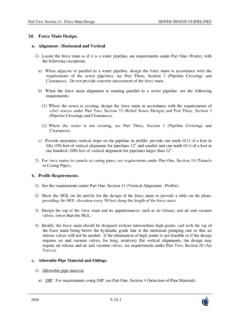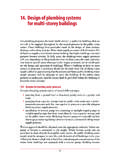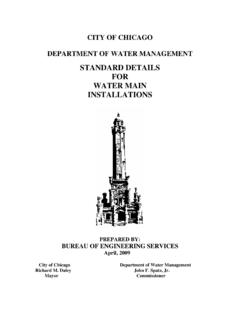Transcription of United States Environmental Protection Agency …
1 United States Environmental Protection Agency wastewater technology Fact Sheet Sewers, Pressure DESCRIPTION greater on-lot costs. In areas with varying terrain and population density, it may prove beneficial to install a Conventional wastewater Collection System combination of sewer types. Conventional wastewater collection systems transport This fact sheet discusses a sewer system that uses sewage from homes or other sources by gravity flow pressure to deliver sewage to a treatment system. through buried piping systems to a central treatment Systems that use vacuum to deliver sewage to a facility. These systems are usually reliable and treatment system are discussed in the Vacuum Sewers consume no power. However, the slope requirements Fact Sheet, while gravity flow sewers are discussed in to maintain adequate flow by gravity may require deep the Small Diameter Sewers Fact Sheet. excavations in hilly or flat terrain, as well as the addition of sewage pump stations, which can significantly Pressure Sewers increase the cost of conventional collection systems.
2 Manholes and other sewer appurtenances also add Pressure sewers are particularly adaptable for rural or substantial costs to conventional collection systems. semi-rural communities where public contact with effluent from failing drain fields presents a substantial Alternative health concern. Since the mains for pressure sewers are, by design, watertight, the pipe connections ensure Alternative wastewater collection systems can be cost minimal leakage of sewage. This can be an important effective for homes in areas where traditional collection consideration in areas subject to groundwater systems are too expensive to install and operate. contamination. Two major types of pressure sewer Pressure sewers are used in sparsely populated or systems are the septic tank effluent pump (STEP). suburban areas in which conventional collection system and the grinder pump (GP). Neither requires systems would be expensive. These systems generally any modification to plumbing inside the house. use smaller diameter pipes with a slight slope or follow the surface contour of the land, reducing excavation In STEP systems, wastewater flows into a conventional and construction costs.
3 Septic tank to capture solids. The liquid effluent flows to a holding tank containing a pump and control Pressure sewers differ from conventional gravity devices. The effluent is then pumped and transferred collection systems because they break down large for treatment. Retrofitting existing septic tanks in areas solids in the pumping station before they are served by septic tank/drain field systems would seem to transported through the collection system. Their present an opportunity for cost savings, but a large watertight design and the absence of manholes number (often a majority) must be replaced or eliminates extraneous flows into the system. Thus, expanded over the life of the system because of alternative sewer systems may be preferred in areas insufficient capacity, deterioration of concrete tanks, or that have high groundwater that could seep into the leaks. In a GP system, sewage flows to a vault where sewer, increasing the amount of wastewater to be a grinder pump grinds the solids and discharges the treated.
4 They also protect groundwater sources by sewage into a pressurized pipe system. GP systems do keeping wastewater in the sewer. The disadvantages of not require a septic tank but may require more alternative sewage systems include increased energy horsepower than STEP systems because of the grinding demands, higher maintenance requirements, and action. A GP system can result in significant capital cost Source: C. Falvey, 2001. FIGURE 1 TYPICAL SEPTIC TANK EFFLUENT PUMP. savings for new areas that have no septic tanks or in ultimate design population. Thus, STEP systems may be older areas where many tanks must be replaced or better choices in these areas than GP systems. repaired. Figure 1 shows a typical septic tank effluent pump, while Figure 2 shows a typical grinder pump APPLICABILITY. used in residential wastewater treatment. Pressure sewer systems are most cost effective where The choice between GP and STEP systems depends housing density is low, where the terrain has undulations on three main factors, as described below: with relatively high relief, and where the system outfall must be at the same or a higher elevation than most or Cost: On-lot facilities, including pumps and tanks, will all of the service area.
5 They can also be effective account for more than 75 percent of total costs, and where flat terrain is combined with high ground water or may run as high as 90 percent. Thus, there is a strong bedrock, making deep cuts and/or multiple lift stations motivation to use a system with the least expensive on- excessively expensive. They can be cost effective even lot facilities. STEP systems may lower on-lot costs in densely populated areas where difficult construction because they allow some gravity service connections or right of way conditions exist, or where the terrain will due to the continued use of a septic tank. In addition, not accommodate gravity sewers. a grinder pump must be more rugged than a STEP. pump to handle the added task of grinding, and, Since pressure systems do not have the large excess consequently, it is more expensive. If many septic capacity typical of conventional gravity sewers, they tanks must be replaced, costs will be significantly must be designed with a balanced approach, keeping higher for a STEP system than a GP system.
6 Future growth and internal hydraulic performance in mind. Downstream Treatment: GP systems produce a higher TSS that may not be acceptable at a downstream ADVANTAGES AND DISADVANTAGES. treatment facility. Advantages Low Flow Conditions: STEP systems will better tolerate low flow conditions that occur in areas with Pressure sewer systems that connect several residences highly fluctuating seasonal occupancy and those with to a cluster pump station can be less expensive than slow build out from a small initial population to the Structural Polypropylene Cover Guide Rails Control Panel and Visual High Water Alarm Structural Lifting Chain Plastic Junction Box PVC Ball Type Shut Off Valve and Handle PVC. Discharge Pipe High Water Alarm Mercury Level Control Inlet Hub (Field Mounted). ON and OFF. Mercury Level Controls 2 HP Grinder Pump 24 Diameter by 60 . Fiberglass Basin Concrete Source: Meyers Company, 2000. FIGURE 2 TYPICAL GRINDER PUMP. conventional gravity systems. On-property facilities constructed and are borne by the homeowner.
7 Low represent a major portion of the capital cost of the front-end investment makes the present-value cost of entire system and are shared in a cluster arrangement. the entire system lower than that of conventional gravity This can be an economic advantage since on-property sewerage, especially in new development areas where components are not required until a house is homes are built over many years. Because wastewater is pumped under pressure, gravity The operation and maintenance (O&M) cost flow is not necessary and the strict alignment and slope for a pressure system is often higher than a restrictions for conventional gravity sewers can be conventional gravity system due to the high relaxed. Network layout does not depend on ground number of pumps in use. However, lift stations contours: pipes can be laid in any location and in a conventional gravity sewer can reverse this extensions can be made in the street right-of-way at a situation. relatively small cost without damage to existing structures.
8 Annual preventive maintenance calls are usually scheduled for GP components of pressure Other advantages of pressure sewers include: sewers. STEP systems also require pump-out of septic tanks at two to three year intervals. Material and trenching costs are significantly lower because pipe size and depth Public education is necessary so the user requirements are reduced. knows how to deal with emergencies and how to avoid blockages or other maintenance Low-cost clean outs and valve assemblies are problems. used rather than manholes and may be spaced further apart than manholes in a conventional The number of pumps that can share the same system. downstream force main is limited. Infiltration is reduced, resulting in reductions in Power outages can result in overflows if pipe size. standby generators are not available. The user pays for the electricity to operate the Life cycle replacement costs are expected to pump unit. The resulting increase in electric be higher because pressure sewers have a bills is small and may replace municipality or lower life expectancy than conventional community bills for central pumping eliminated systems.
9 By the pressure system. Odors and corrosion are potential problems because Final treatment may be substantially reduced in the wastewater in the collection sewers is usually septic. hydraulic and organic loading in STEP Proper ventilation and odor control must be provided systems. Hydraulic loadings are also reduced in the design and non-corrosive components should be for GP systems. used. Air release valves are often vented to soil beds to minimize odor problems and special discharge and Because sewage is transported under pressure, treatment designs are required to avoid terminal more flexibility is allowed in siting final discharge problems. treatment facilities and may help reduce the length of outfall lines or treatment plant DESIGN CRITERIA. construction costs. Many different design flows can be used in pressure Disadvantages systems. When positive displacement GP units are used, the design flow is obtained by multiplying the Requires much institutional involvement pump discharge by the maximum number of pumps because the pressure system has many expected to be operating simultaneously.
10 When mechanical components throughout the service centrifugal pumps are used, the equation used is Q= 20. area. + , where Q is the flow in gpm and D is the number of homes served. The operation of the system under various assumed conditions should be simulated by computer to check design adequacy. No agencies, and the Audubon Society to replace the allowances for infiltration and inflow are required. No undersized septic tanks with larger ones equipped with minimum velocity is generally used in design, but GP STEP units and low pressure sewerage ultimately systems must attain three to five feet per second at least discharging to a constructed wetland. This system is once per day. A Hazen-Williams coefficient, (C) = expected to achieve an effluent quality of less than 20. 130 to 140, is suggested for hydraulic analysis. mg/L each of BOD and TSS, less than 8 mg/L. Pressure mains generally use 50 mm (2 inch) or larger ammonia, and greater than 4 mg/L dissolved oxygen PVC pipe (SDR 21) and rubber-ring joints or solvent (Jensen 1999).
















